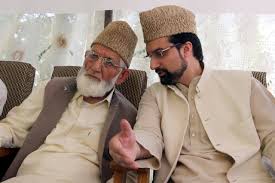They have joined hands to oppose the ‘Sainik colony’ and ‘exclusive townships’ for migrant Pandits
Arun Joshi
 Kashmiri separatists have “united”. Some pictures showing icons of separatism Syed Ali Shah Geelani, Mirwaiz Umar Farooq and Mohammad Yasin Malik — representing three different thoughts vis-à-vis the Kashmir solution —- huddled together have appeared to reinforce the substance in the symbolism.
Kashmiri separatists have “united”. Some pictures showing icons of separatism Syed Ali Shah Geelani, Mirwaiz Umar Farooq and Mohammad Yasin Malik — representing three different thoughts vis-à-vis the Kashmir solution —- huddled together have appeared to reinforce the substance in the symbolism.
Geelani is all for implementation of the United Nations Security Council resolutions of 1948-49, Mirwaiz Umar Farooq is a pragmatic leader who wants dialogue to determine the course of the outcome and Mohammad Yasin Malik is the loudest voice for independence of Kashmir from both India and Pakistan. They all have joined hands to oppose the “Sainik colony” and “exclusive townships” for migrant Kashmiri Pandits.
Their pictures standing together tell only half of the story. It is being made out as if the separatists were born fighting each other and now they have united to fight together for the cause of the identity of Kashmiri Muslims against the “onslaught of the RSS,” which they proclaim is all set to gain space in the Muslim-majority state through overt and covert means. All of them were part of the All Parties Hurriyat Conference in the mid-1990s — there was no hardline or moderate faction, though there always were clashes of egos on issues. The expulsion of Shabir Shah, Malik walking in and out of the group, Geelani unable to reconcile himself to the leadership of Moulvi Abbas Ansari as head of the group are part of the history of the separatist camp. They have been here before, too.
Looking at it from any angle, this unity is not the recovery of the same old APHC, which was formed in the winter of 1992 and bloomed in the spring of 1993. The Mirwaiz, then in his teens, was made the chairman because some of the leaders would not agree to work under each other. Syed Ali Shah Geelani and the late Abdul Ghani Lone were rarely in agreement with each other.
This time they see the RSS spreading its wings by making the “pliable PDP of Mehbooba Mufti” to agree to set up “exclusive townships” for migrant Kashmiri Pandits and “Sainik colonies” for retired soldiers of the state. They want this to be converted into a resistance movement because the “townships for Kashmiri Pandits” are seen by them as an excuse to settle outsiders. Thus, this is a war for preserving the Kashmiri Muslim identity.
“No sainik colony will ever be allowed, whether it is for the state subject soldiers or others,” thundered JKLF’s Yasin Malik. “Why a colony for the soldiers when the retired policemen don’t ask or have such colonies?” he argued. There is no counter-argument that the separatists want to hear. They see a conspiracy in these proposals.
“Kashmiri Pandit migrants are our brothers, let them come and live where they used to (before migration), why exclusive colonies (for them),” questions Geelani. “It (Centre) wants to settle outsiders and inflict religious strife in the Valley,” the hardline separatist leader voices this thesis to prove that his fears about such steps were genuine.
Primarily, it may appear that they are seeking to link these proposed colonies to the overall solution of Kashmir. It is a smoke screen to keep the pot boiling. The opposition to the return of Pandits to exclusive zones has its own dynamics. It is to shut doors on them. There are no places for them to stay. Kashmiri Muslims are a hospitable community. It can open door to its guests all the time, but the guests cannot overstay their welcome.
Pakistan had been trying hard to get all these factions united. All Pakistani leaders have been asking the factions to unite since 2005.
Since March 2015, this united face has been forced onto them. After the great split in September 2003, for the first time Geelani, Mirwaiz and Yasin Malik appeared together at the fourth-day ceremony of a young boy killed in police firing in Narbal on the outskirts of Srinagar. The last time when separatist leaders were seen walking together was when they went to the Pakistan High Commission in July 2001 when Pervez Musharraf had visited Delhi for the Agra summit, now a failed milestone in the Indo-Pak diplomatic history.
Pakistan has ensured now that once these groups show some sort of symbolic unity, it would become difficult for India to engage any of the factions in talks. There were talks with the Mirwaiz faction from January 2004 to May 2006. Yasin Malik and Sajjad Gani Lone had met Prime Minister Manmohan Singh in the early part of 2006.
Delhi has pushed them to this “unity”. It did not offer them any dialogue nor made any attempt to talk to them. A striking fact is that separatists, despite their ups and downs, retain a symbolic value. They have not disappeared despite a series of elections. They still control certain forces, which India cannot afford to overlook. India needs to ponder over that.





